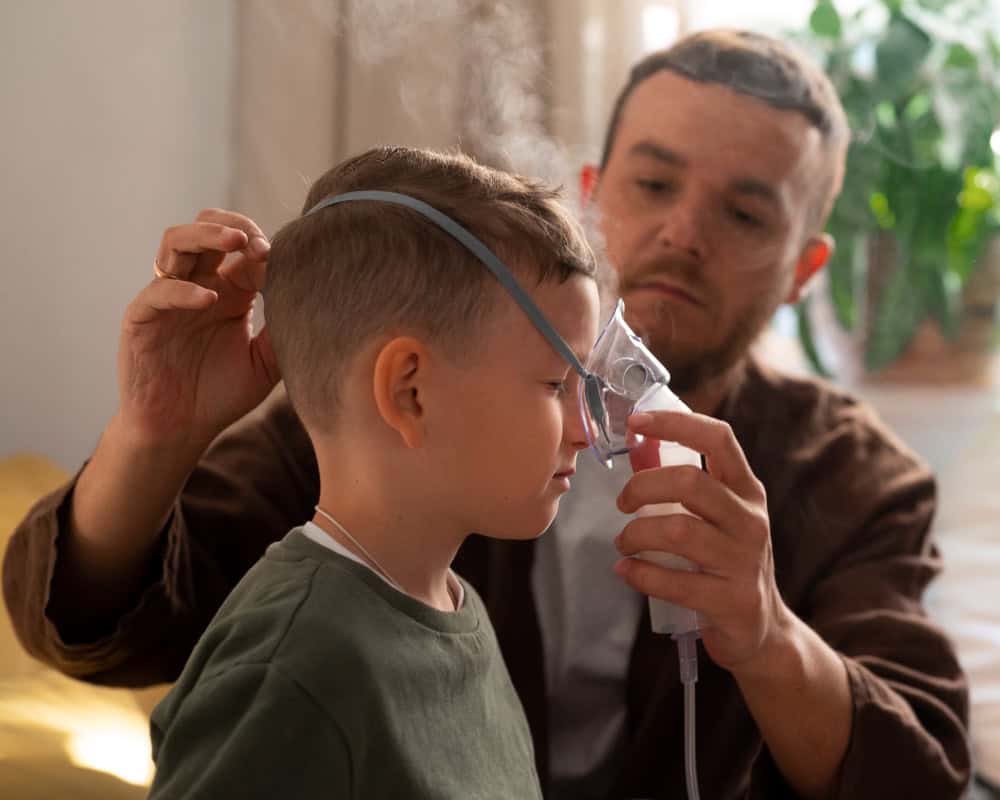Childhood asthma is a prevalent chronic condition that affects millions of children worldwide. It can significantly impact a child’s daily life, making it difficult to breathe, play, and participate in activities. For parents and caregivers, understanding and effectively managing this condition is crucial to the child’s health and well-being. In this blog post, we’ll delve into the fundamentals of childhood asthma, explore its causes, symptoms, and diagnosis, and discuss various treatment options and management strategies.
What is Asthma?
Asthma is a chronic respiratory condition characterized by inflammation and narrowing of the airways in the lungs. This makes it difficult for air to move in and out, leading to symptoms like wheezing, coughing, shortness of breath, and chest tightness.
Several factors can trigger or exacerbate asthma symptoms, including allergens (e.g., pollen, pet dander, dust mites), irritants (e.g., smoke, pollution), respiratory infections, exercise, and even emotional stress. The severity and frequency of these symptoms can vary significantly from child to child, making it essential to understand the individual triggers and tailor treatment accordingly.
Diagnosing Childhood Asthma
Early recognition and diagnosis of childhood asthma are important for timely intervention and effective management. If your child exhibits persistent coughing, wheezing, or difficulty breathing, it’s important to consult with a healthcare professional who specializes in pediatric care.
They will conduct a comprehensive evaluation, including a detailed medical history, physical examination, and potentially some tests to assess lung function and rule out other possible conditions. These tests may include spirometry (measuring lung capacity and airflow), allergy testing, and sometimes even imaging studies like chest X-rays.
Diagnosing Childhood Asthma
Managing childhood asthma involves a multifaceted approach that combines medication and lifestyle adjustments. Medications for asthma fall into two main categories: controllers and relievers. Controllers are long-term medications taken daily to reduce airway inflammation and prevent symptoms, while relievers are quick-acting medications used to open up the airways during an asthma attack.
In addition to medication, lifestyle modifications such as identifying and avoiding triggers, maintaining a clean and dust-free environment, and promoting regular exercise can significantly improve asthma control.
Asthma Action Plan
A personalized asthma action plan is important for managing this condition effectively. This plan is developed in collaboration with healthcare providers, parents, and the child, and it outlines specific steps to take based on the child’s symptoms and peak flow readings (a measure of lung function).
The plan typically includes information on daily medications, when and how to use rescue medications, and what to do if symptoms worsen. Having a clear and easy-to-follow action plan empowers parents and caregivers to respond promptly and appropriately to changes in the child’s condition, ultimately reducing the risk of severe asthma attacks.
Living With Childhood Asthma
Living with childhood asthma involves adapting daily routines to minimize triggers and manage symptoms. At home, this may include using dust mite covers on bedding, regularly cleaning carpets and floors, and keeping pets out of bedrooms. At school, it’s important to communicate with teachers and staff about the child’s asthma action plan and ensure they have access to their medication.
Regular exercise is encouraged, but should be tailored to the child’s individual needs and triggers. Open communication between parents, children, and healthcare providers is vital for ongoing monitoring and adjusting treatment as needed.
Supporting Resources for Parents and Caregivers
Many resources are available to support parents and caregivers of children with asthma. Organizations like the Asthma and Allergy Foundation of America (AAFA) and the American Lung Association provide valuable information, educational materials, and support groups. Online resources and forums can connect parents with others who are facing similar challenges, fostering a sense of community and shared understanding. These resources can offer guidance on managing asthma triggers, navigating school accommodations, and coping with the emotional impact of the condition on both children and families.
Trust LaTouche Pediatrics For Your Childhood Asthma Care
Understanding childhood asthma, its triggers, symptoms, and treatment options is the first step toward effective management. By developing a personalized asthma action plan, making necessary lifestyle changes, and seeking support from healthcare providers and community resources, parents and caregivers can empower their children to live full and active lives despite this chronic condition.
The Anchorage pediatricians at LaTouche Pediatrics are dedicated to providing comprehensive childhood asthma care. We offer personalized treatment plans, asthma testing, and ongoing support. Contact us today to schedule an appointment and start exploring ways to manage your child’s allergies effectively.
Key Takeaways
- Childhood asthma is a common chronic condition that can significantly impact a child’s life, but with proper management children can lead healthy and active lives.
- Understanding asthma triggers and tailoring treatment accordingly is crucial for effective management.
- Early diagnosis and intervention are key to minimizing the impact of asthma on a child’s development and well-being.
- Personalized asthma action plans empower parents and caregivers to respond promptly to changes in the child’s condition.
- Lifestyle modifications and open communication with healthcare providers are essential for ongoing asthma management.
- Numerous resources are available to support parents and caregivers of children with asthma.

